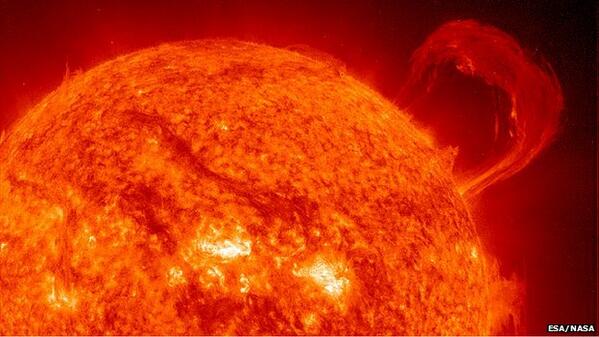(单词翻译:单击)
听力文本
What does the Sun sound like? Perhaps you have never thought about what kinds of sounds the Sun makes, but scientists have found out. Researchers from the European Space Agency, NASA and the Solar and Heliospheric Agency studied 20 years of data to listen to the Sun. They say the Sun produces a low, deep "heartbeat" sound. The scientists used a solar observatory to measure vibrations from the Sun. They translated these vibrations into different sounds. These can tell the scientists what is happening inside the Sun. They can now understand more about solar flares, chemical reactions and other phenomena that happen inside the Sun and on its surface.

The scientists explained how they created the Sun's sound. Researchers from the Stanford Experimental Physics Lab turned data from the space agencies into a "song". Dr Alex Young said: "We don't have straightforward ways to look inside the Sun. We don't have a microscope to zoom inside the Sun, so using a star or the Sun's vibrations allows us to see inside of it." Dr Young continued: "Waves are travelling and bouncing around inside the Sun, and if your eyes were sensitive enough, they could actually see this." He added: "We are finally starting to understand the layers of the Sun and the complexity. That simple sound is giving us a probe inside a star. I think that's a pretty cool thing."
译文由可可原创,仅供学习交流使用,未经许可请勿转载。
重点解析
1.They can now understand more about solar flares, chemical reactions and other phenomena that happen inside the Sun and on its surface.
phenomena 现象
Science rests on phenomena.
科学以现象为根据。
2....if your eyes were sensitive enough, they could actually see this.
sensitive 敏感的
This instrument is highly sensitive.
这架仪器很灵敏。
参考翻译
太阳的声音是什么样的?或许你从未想过太阳会发出什么样的声音,但是科学家们却已有了发现。来自欧洲太空总署、美国国家宇航局以及太阳能子午观测站的研究人员对20年的数据进行研究只为听到太阳的声音。他们表示太阳产生低沉的“心跳”声。科学家们利用太阳天文台测量太阳的振幅。他们将这些振幅翻译成了不同的声音。这些声音能够告诉科学家太阳里边发生了什么。如今他们可以对太阳耀斑、化学反应以及太阳内部和表面发生的其他现象有更多的理解。
科学家们解释了他们是如何创造出太阳的声音的。斯坦福实验物理实验室的研究人员将来自宇航局的数据转化成了“一首歌”。历克斯·杨博士表示:“我们没有直接探查太阳内部的方法,也没有显微镜可以观察太阳内部,所以我们利用恒星或是太阳的振幅来观测太阳内部。”杨博士继续说道:“波长在太阳内部行走回弹,如果你的眼睛足够敏锐的话,是可以看得见这些波长的。”他补充到:“我们终于开始对太阳层及其复杂性有了些了解。那个简单的声音是我们探查恒星的探测器。我想这是一件相当棒的事。”


